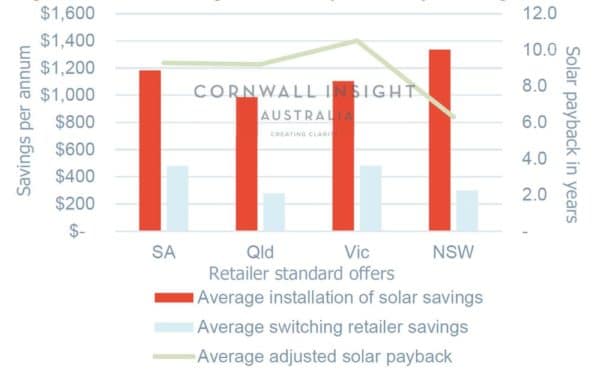The graph below compares the choice between installing rooftop solar with one of the big three retailer’s standard offers or switching to a lower-cost retailer without installing solar.
As well as our calculations of the payback period of the solar install using the retailer savings as an opportunity cost. This means the adjusted payback only reflects the additional savings from installing solar.

Image: Cornwall Insights
Benjamin Macey, senior storage consultant at Cornwall Insight Australia, said: “In most states, electricity retailers determine and set their own rooftop solar feed-in tariffs (FiTs). A major driver of these tariffs is wholesale energy prices. Wholesale energy prices have continued to decline during the midday period. As the solar weighted wholesale energy prices reduce or become negative, it reduces the benefit of rooftop solar feed-in for retailers and, in turn, reduces the solar FiTs offered.
“Cornwall Insight Australia’s research shows that the big three retailers offer higher solar FiTs but offset these with higher overall electricity charges. This causes an inflated return for solar. Hence consumers need to assess and compare the real benefits of solar based on the energy costs and solar FiTs across multiple retailers.
“Overall, the payback period for exporting rooftop solar decreases as lower mid-day energy prices act as a market signal to reduce solar FiTs.
“As this trend continues, it will encourage active self-consumption of rooftop solar through energy storage. This, combined with ‘solar sponge’ network tariffs and VPPs, could slow rooftop solar for export, reducing the urgency for solar export charges/services proposed under the AEMC draft rule change ERC0311.
“With support from government schemes such as the SA Home Battery Scheme and decreasing battery prices, it might not be long before we see strong growth in distributed energy storage.
“If this eventuates, distributed storage could play a key role in the NEM, contributing to system security, reliability and potentially reduce the scale of future network upgrades.”






By submitting this form you agree to pv magazine using your data for the purposes of publishing your comment.
Your personal data will only be disclosed or otherwise transmitted to third parties for the purposes of spam filtering or if this is necessary for technical maintenance of the website. Any other transfer to third parties will not take place unless this is justified on the basis of applicable data protection regulations or if pv magazine is legally obliged to do so.
You may revoke this consent at any time with effect for the future, in which case your personal data will be deleted immediately. Otherwise, your data will be deleted if pv magazine has processed your request or the purpose of data storage is fulfilled.
Further information on data privacy can be found in our Data Protection Policy.